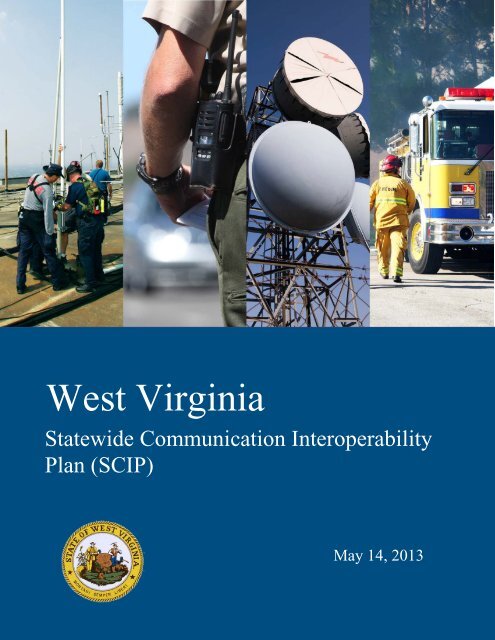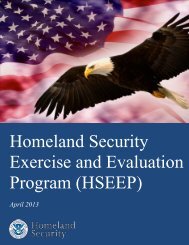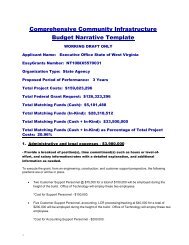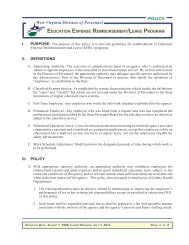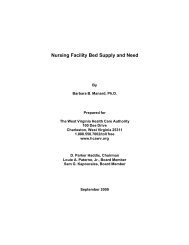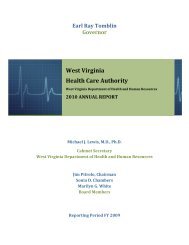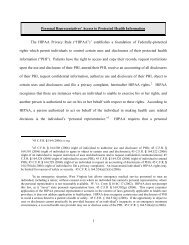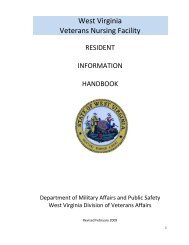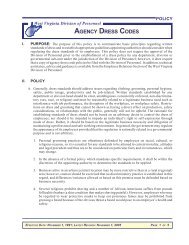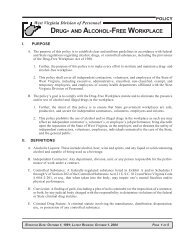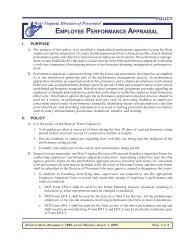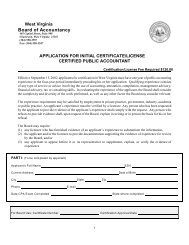What is SIRN? - State of West Virginia
What is SIRN? - State of West Virginia
What is SIRN? - State of West Virginia
- No tags were found...
You also want an ePaper? Increase the reach of your titles
YUMPU automatically turns print PDFs into web optimized ePapers that Google loves.
<strong>West</strong> <strong>Virginia</strong><strong>State</strong>wide Communication InteroperabilityPlan (SCIP)May 14, 2013
WEST VIRGINIAEXECUTIVE SUMMARY<strong>West</strong> <strong>Virginia</strong>’s <strong>State</strong>wide Communication Interoperability Plan (SCIP) <strong>is</strong> a stakeholderdriven,multi-jur<strong>is</strong>dictional, and multi-d<strong>is</strong>ciplinary statewide strategic plan to enhanceinteroperable and emergency communications. The SCIP <strong>is</strong> a critical mid-range (threeto five years) strategic planning tool to help <strong>West</strong> <strong>Virginia</strong> prioritize resources,strengthen governance, identify future investments, and address interoperability gaps.The purpose <strong>of</strong> the <strong>West</strong> <strong>Virginia</strong> SCIP <strong>is</strong>:• To provide the strategic direction and alignment for those responsible forinteroperable and emergency communications at the <strong>State</strong>, regional, and locallevels.• To explain to leadership and elected <strong>of</strong>ficials the v<strong>is</strong>ion for interoperable andemergency communications and demonstrate the need for funding.• To guide public safety communications and to solve interoperability within the<strong>State</strong>.• To encourage the development <strong>of</strong> interoperable emergency communicationsguidelines, common standards, and procedures.• To develop and provide training, education, and outreach for interoperablecommunications that can be used by all entities statewide.The following are <strong>West</strong> <strong>Virginia</strong>’s V<strong>is</strong>ion and M<strong>is</strong>sion for improving emergencycommunications operability, interoperability, and continuity <strong>of</strong> communicationsstatewide.V<strong>is</strong>ion: To coordinate resources and improve statewide public safety wirelesscommunications interoperability; to establ<strong>is</strong>h and develop policies and guidelines, andidentify technology and standards affording the citizens <strong>of</strong> <strong>West</strong> <strong>Virginia</strong> safety andenhanced response thereby protecting life, limb, and property.M<strong>is</strong>sion: To establ<strong>is</strong>h, maintain, and facilitate interoperable communications for publicsafety in <strong>West</strong> <strong>Virginia</strong>.The following strategic goals represent the priorities for delivering <strong>West</strong> <strong>Virginia</strong>’s v<strong>is</strong>ionfor interoperable and emergency communications.• Governance –o Codify the <strong>State</strong>wide Interoperability Executive Committee (SIEC)governance body through leg<strong>is</strong>lation to oversee and admin<strong>is</strong>ter the<strong>State</strong>wide Interoperable Radio Network (<strong>SIRN</strong>) and other technologies.o Establ<strong>is</strong>h dedicated funding for the <strong>State</strong>wide Interoperability Coordinator(SWIC), technical, and admin<strong>is</strong>trative staffing positions as a line item inthe <strong>State</strong> budget.WEST VIRGINIA STATEWIDE COMMUNICATION INTEROPERABILTY PLAN 1
WEST VIRGINIA• Standard Operating Procedures (SOPs) –o Develop, execute, and maintain SOPs for systems (legacy, <strong>SIRN</strong>,broadband) and cross-border usage at local, regional, and <strong>State</strong> levels.• Technology –o Provide redundancy (microwave loops, auto-router switching, Ethernet)within the <strong>SIRN</strong> while continuing to improve statewide coverage andcompleting the system.o Develop and finalize the <strong>West</strong> <strong>Virginia</strong> <strong>State</strong> and multi-state regionalbroadband plan(s) in conjunction with the Nationwide Public SafetyBroadband Network (NPSBN)/FirstNet Nationwide Network (FNN).o Identify and develop public safety applications (e.g. apps for smartphones, tablets) for the NPSBN/FNN.• Training and Exerc<strong>is</strong>es –• Usage –o Develop and provide training and ass<strong>is</strong>t in exerc<strong>is</strong>es to continuouslyvalidate statewide interoperability.o Leverage technology to facilitate interoperability for all Homeland Security,Emergency Responders, non-government agencies, and others statewide.• Outreach and Information Sharing –o To leverage ex<strong>is</strong>ting SIEC, Regional Interoperability Committees (RICs),and the Broadband and Training Committee to engage and obtainconsensus <strong>of</strong> <strong>State</strong> and local stakeholders when providing information andresponding to FirstNet requests.o Establ<strong>is</strong>h an outreach and information sharing program for all 55 countiesto inform stakeholders and solicit feedback for <strong>SIRN</strong> and FirstNetactivities.• Life Cycle Funding –o Establ<strong>is</strong>h dedicated sustainable funding for the construction, operation,admin<strong>is</strong>tration, and maintenance <strong>of</strong> the <strong>SIRN</strong> as a line item in the <strong>State</strong>budget.o Establ<strong>is</strong>h a life cycle plan and funding for statewide participation in theNPSBN/FNN as a line item in the <strong>State</strong> budget.WEST VIRGINIA STATEWIDE COMMUNICATION INTEROPERABILTY PLAN 2
WEST VIRGINIATABLE OF CONTENTSExecutive Summary ............................................................................................................................... 11. Introduction ...................................................................................................................................... 42. Purpose ............................................................................................................................................ 93. <strong>State</strong>’s Interoperable and Emergency Communications Overview ...................................... 104. V<strong>is</strong>ion and M<strong>is</strong>sion ....................................................................................................................... 105. Strategic Goals And Initiatives ................................................................................................... 115.1 Governance ........................................................................................................................... 115.2 Standard Operating Procedures (SOPs) .......................................................................... 125.3 Technology ............................................................................................................................ 135.4 Training and Exerc<strong>is</strong>es ........................................................................................................ 145.5 Usage ..................................................................................................................................... 155.6 Outreach and Information Sharing .................................................................................... 165.7 Life Cycle Funding................................................................................................................ 176. Implementation ............................................................................................................................. 186.1 Action Plan ............................................................................................................................ 186.2 Measures <strong>of</strong> Success .......................................................................................................... 186.3 Management <strong>of</strong> Success ..................................................................................................... 206.4 Strategic Plan Review.......................................................................................................... 207. Reference Documents ................................................................................................................. 20Appendix A: L<strong>is</strong>t <strong>of</strong> Acronyms ............................................................................................................ 22WEST VIRGINIA STATEWIDE COMMUNICATION INTEROPERABILTY PLAN 3
WEST VIRGINIA1. INTRODUCTION<strong>West</strong> <strong>Virginia</strong>’s <strong>State</strong>wide Communication Interoperability Plan (SCIP) <strong>is</strong> a stakeholderdriven,multi-jur<strong>is</strong>dictional, and multi-d<strong>is</strong>ciplinary statewide strategic plan to enhanceinteroperable and emergency communications. The SCIP <strong>is</strong> a critical mid-range (threeto five years) strategic planning tool to help <strong>West</strong> <strong>Virginia</strong> prioritize resources,strengthen governance, identify future investments, and address interoperability gaps.Th<strong>is</strong> document contains the following planning components:• Introduction – Provides the context necessary to understand what the SCIP <strong>is</strong>and how it was developed.• Purpose – Explains the purpose/function(s) <strong>of</strong> the SCIP in <strong>West</strong> <strong>Virginia</strong>.• <strong>State</strong>’s Interoperable and Emergency Communications Overview – Provides anoverview <strong>of</strong> the <strong>State</strong>’s current and future emergency communicationsenvironment (e.g., statewide or regional interoperable and emergencycommunications systems and defines ownership <strong>of</strong> the SCIP).• V<strong>is</strong>ion and M<strong>is</strong>sion – Articulates the <strong>State</strong>’s three- to five-year v<strong>is</strong>ion and m<strong>is</strong>sionfor improving emergency communications operability, interoperability, andcontinuity <strong>of</strong> communications at all levels <strong>of</strong> government.• Strategic Goals and Initiatives – Outlines the strategic goals and initiativesaligned with the three- to five-year v<strong>is</strong>ion and m<strong>is</strong>sion <strong>of</strong> the SCIP and pertains tothe following critical components: Governance, Standard Operating Procedures(SOPs), Technology, Training and Exerc<strong>is</strong>es, Usage, Outreach and InformationSharing, and Life Cycle Funding.• Implementation – Describes the process to evaluate the success <strong>of</strong> the SCIP andto conduct SCIP reviews to ensure it <strong>is</strong> up-to-date and aligned with the changinginternal and external environment.• Reference Documents – Includes documents that provide additional backgroundinformation on the SCIP or interoperable and emergency communications in<strong>West</strong> <strong>Virginia</strong> or directly support the SCIP.Figure 1 provides additional information about how these components <strong>of</strong> the SCIPinterrelate to develop a comprehensive plan for improving interoperable and emergencycommunications.WEST VIRGINIA STATEWIDE COMMUNICATION INTEROPERABILTY PLAN 4
WEST VIRGINIAFigure 1: SCIP Strategic Plan and Implementation ComponentsThe <strong>West</strong> <strong>Virginia</strong> SCIP <strong>is</strong> based on an understanding <strong>of</strong> the current and mid-rangeinteroperable and emergency communications environment. <strong>West</strong> <strong>Virginia</strong> has takensignificant steps towards enhancing interoperable and emergency communications,including:• Enhancing overall coverage and users within the <strong>State</strong>wide Interoperable RadioNetwork (<strong>SIRN</strong>) by providing tower and microwave radios• Updating the <strong>State</strong>wide Interoperable Executive Committee (SIEC) ExecutiveOrder to include Regional Interoperability Committees (RICs) to incorporate locallevel input and participation• Establ<strong>is</strong>hing a broadband committee within the SIEC to plan for emergingtechnologies• Strengthening inter- and intra-<strong>State</strong> planning through regular coordination withother <strong>State</strong>s (e.g. Mid-Atlantic Consortium for Interoperable NationwideAdvanced Communications (MACINAC), FEMA’s Region-III Regional EmergencyCommunications Coordination Working Group (RECCWG) and other surrounding<strong>State</strong>s)WEST VIRGINIA STATEWIDE COMMUNICATION INTEROPERABILTY PLAN 5
WEST VIRGINIAHowever, more remains to be done to achieve <strong>West</strong> <strong>Virginia</strong>’s v<strong>is</strong>ion. It <strong>is</strong> also importantto note that th<strong>is</strong> work <strong>is</strong> part <strong>of</strong> a continuous cycle as <strong>West</strong> <strong>Virginia</strong> will always need toadapt to evolving technologies, operational tactics, and changes to key individuals (e.g.Governor, project champions). In the next three to five years, <strong>West</strong> <strong>Virginia</strong> willencounter challenges relating to operability, interoperability, geography, agingequipment/systems, emerging technologies, changing project champions, andsustainable funding.Wireless voice and data technology <strong>is</strong> evolving rapidly and efforts are underway todetermine how to leverage these new technologies to meet the needs <strong>of</strong> public safety.For example, the enactment <strong>of</strong> the Middle Class Tax Relief and Job Creation Act <strong>of</strong>2012 (the Act), specifically Title VI, related to Public Safety Communications, authorizesthe deployment <strong>of</strong> the Nationwide Public Safety Broadband Network (NPSBN). TheNPSBN, now referred to as the FirstNet Nationwide Network (FNN), <strong>is</strong> intended to be awireless, interoperable nationwide communications network that will allow members <strong>of</strong>the public safety community to securely and reliably gain and share information withtheir counterparts in other locations and agencies. New policies and initiatives such asthe NPSBN present additional changes and considerations for future planning effortsand require an informed strategic v<strong>is</strong>ion to properly account for these changes. Figure 2illustrates a public safety communications evolution by describing the long-termtransition toward a desired converged future.Figure 2: Public Safety Communications EvolutionIntegrating capabilities such as broadband provides an unparalleled opportunity for thefuture <strong>of</strong> interoperable communications in <strong>West</strong> <strong>Virginia</strong>. It may result in a secure pathfor information-sharing initiatives, Public Safety Answering Points (PSAP), and NextGeneration 9-1-1 (NG9-1-1) integration. Broadband will not replace ex<strong>is</strong>ting LandWEST VIRGINIA STATEWIDE COMMUNICATION INTEROPERABILTY PLAN 6
WEST VIRGINIAMobile Radio (LMR) voice systems in the foreseeable future due to implementationfactors associated with planning, deployment, technology, and cost. A cautiousapproach to th<strong>is</strong> investment <strong>is</strong> needed. Therefore, robust requirements and innovativebusiness practices must be developed for broadband initiatives prior to anyimplementation.There <strong>is</strong> no defined timeline for the deployment <strong>of</strong> the NPSBN/FNN; however, <strong>West</strong><strong>Virginia</strong> will keep up-to-date with the planning and build-out <strong>of</strong> the NPSBN/FNN in thenear and long term in coordination with the First Responder Network Authority(FirstNet). FirstNet <strong>is</strong> the independent authority within the National Telecommunicationsand Information Admin<strong>is</strong>tration (NTIA) and <strong>is</strong> responsible for developing the NPSBN/FNN, which will be a single, nationwide, interoperable public safety broadband network.The network build-out will require continuing education and commitment at all levels <strong>of</strong>government and across public safety d<strong>is</strong>ciplines to document network requirements andidentify ex<strong>is</strong>ting resources and assets that could potentially be used in the build-out <strong>of</strong>the network. It will also be necessary to develop and maintain strategic partnershipswith a variety <strong>of</strong> stakeholder agencies and organizations at the national, <strong>State</strong>, regional,and local levels and design effective policy and governance structures that address newand emerging interoperable and emergency communications technologies. During th<strong>is</strong>process, investments in LMR will continue to be necessary and in the near term,wireless data systems or commercial broadband will complement LMR. Moreinformation on the role <strong>of</strong> these two technologies in interoperable and emergencycommunications <strong>is</strong> available in the Department <strong>of</strong> Homeland Security’s (DHS) Office <strong>of</strong>Emergency Communications (OEC) Public Safety Communications Evolutionbrochure. 1In 2010, <strong>West</strong> <strong>Virginia</strong> received a Broadband Technology Opportunities Program(BTOP) grant in which the <strong>State</strong> was able to upgrade the statewide microwave systemas well as other <strong>SIRN</strong> equipment in preparation for the NPSBN/FNN. In addition, <strong>West</strong><strong>Virginia</strong>’s SIEC establ<strong>is</strong>hed a Broadband Committee to ass<strong>is</strong>t with the preparation <strong>of</strong><strong>State</strong> broadband plans and SOPs.Additionally, achieving sustainable funding in the current f<strong>is</strong>cal climate <strong>is</strong> a priority for<strong>West</strong> <strong>Virginia</strong>. As <strong>State</strong> and Federal grant funding dimin<strong>is</strong>hes, <strong>State</strong>s need to identifyalternative funding sources to continue improving interoperable and emergencycommunications for voice and data systems. Key priorities for sustainable funding in<strong>West</strong> <strong>Virginia</strong> are:• To ensure radio interoperability so that first responders from different jur<strong>is</strong>dictionshave the ability to communicate in the same talk group to collaborate andcoordinate during emergency responses.• To ensure that the <strong>West</strong> <strong>Virginia</strong> <strong>State</strong>wide Interoperability Coordinator (SWIC)has the resources necessary to continue to be an inter- and intra-<strong>State</strong> leader forinteroperable and emergency communications.1 OEC’s Public Safety Communications Evolution brochure <strong>is</strong> available here:http://publicsafetytools.info/oec_guidance/docs/Public_Safety_Communications_Evolution_Brochure.pdfWEST VIRGINIA STATEWIDE COMMUNICATION INTEROPERABILTY PLAN 7
WEST VIRGINIA• To ensure full life cycle support <strong>of</strong> interoperable and emergency communicationssystems.• To develop a <strong>West</strong> <strong>Virginia</strong> Communications Office to support <strong>West</strong> <strong>Virginia</strong>’sSWIC, <strong>SIRN</strong>, FirstNet, and <strong>State</strong>-level communications personnel.More information on a typical emergency communications system life cycle, costplanning, and budgeting <strong>is</strong> available in OEC’s System Life Cycle Planning Guide. 2Figure 3: The Interoperability ContinuumThe Interoperability Continuum, developed by SAFECOM and shown in Figure 3,serves as a framework to address all <strong>of</strong> these challenges and continue improvingoperable/interoperable and emergency communications. It <strong>is</strong> designed to ass<strong>is</strong>temergency response agencies and policy makers with planning and implementinginteroperability solutions for voice and data communications.The Continuum identifies five critical success elements that must be addressed toachieve a successful interoperable communications solution:• Governance – Collaborative dec<strong>is</strong>ion-making process that supportsinteroperability efforts to improve communication, coordination, and cooperationacross d<strong>is</strong>ciplines and jur<strong>is</strong>dictions. Governance <strong>is</strong> the critical foundation <strong>of</strong> all <strong>of</strong><strong>West</strong> <strong>Virginia</strong>’s efforts to address communications interoperability.• SOPs – Policies, repetitive practices, and procedures that guide emergencyresponder interactions and the use <strong>of</strong> interoperable communications solutions.2 OEC’s System Life Cycle Planning Guide <strong>is</strong> available here:http://publicsafetytools.info/oec_guidance/docs/OEC_System_Life_Cycle_Planning_Guide_Final.pdfWEST VIRGINIA STATEWIDE COMMUNICATION INTEROPERABILTY PLAN 8
WEST VIRGINIA• Technology – Systems and equipment that enable emergency responders toshare voice and data information efficiently, reliably, and securely.• Training and Exerc<strong>is</strong>es – Scenario-based practices used to enhancecommunications interoperability and familiarize the public safety community withequipment and procedures.• Usage – Familiarity with interoperable communications technologies, systems,and operating procedures used by first responders to enhance interoperability.More information on the Interoperability Continuum <strong>is</strong> available in OEC’s InteroperabilityContinuum brochure 3 . The following sections will further describe how the SCIP will beused in <strong>West</strong> <strong>Virginia</strong> and <strong>West</strong> <strong>Virginia</strong>’s plans to enhance interoperable andemergency communications.2. PURPOSEThe purpose <strong>of</strong> the <strong>West</strong> <strong>Virginia</strong> SCIP <strong>is</strong>:• To provide the strategic direction and alignment for those responsible forinteroperable and emergency communications at the <strong>State</strong>, regional, and locallevels.• To explain to leadership and elected <strong>of</strong>ficials the v<strong>is</strong>ion for interoperable andemergency communications and demonstrate the need for funding.• To guide public safety communications and to solve interoperability within the<strong>State</strong>.• To encourage the development <strong>of</strong> interoperable emergency communicationsguidelines, common standards, and procedures.• To develop and provide training, education, and outreach for interoperablecommunications that can be used by all entities statewide.The development and execution <strong>of</strong> the SCIP ass<strong>is</strong>ts <strong>West</strong> <strong>Virginia</strong> with addressing theresults <strong>of</strong> the National Emergency Communications Plan (NECP) Goals and the Federalgovernment with fulfilling the Presidential Policy Directive 8 (PPD-8) 4 NationalPreparedness Goal for Operational Communications. 5 Th<strong>is</strong> SCIP <strong>is</strong> owned andmanaged by the SIEC. The SIEC has the authority to and <strong>is</strong> responsible for making3 OEC’s Interoperability Continuum <strong>is</strong> available here:http://www.safecomprogram.gov/oecguidancedocuments/continuum/Default.aspx4 PPD-8 was signed in 2011 and <strong>is</strong> compr<strong>is</strong>ed <strong>of</strong> six elements: a National Preparedness Goal, the National Preparedness System,National Planning Frameworks and Federal Interagency Operational Plan, an annual National Preparedness Report, and ongoingnational efforts to build and sustain preparedness. PPD-8 defines a series <strong>of</strong> national preparedness elements and emphasizes theneed for the whole community to work together to achieve the National Preparedness Goal. http://www.dhs.gov/presidential-policydirective-8-national-preparedness.5 National Preparedness Goal – Mitigation and Response M<strong>is</strong>sion Area Capabilities and Preliminary Targets – OperationalCommunications: Ensure the capacity for timely communications in support <strong>of</strong> security, situational awareness, and operations byany and all means available, among and between affected communities in the impact area and all response forces.1. Ensure the capacity to communicate with the emergency response community and the affected populations and establ<strong>is</strong>hinteroperable voice and data communications between Federal, <strong>State</strong>, and local first responders.2. Re-establ<strong>is</strong>h sufficient communications infrastructure within the affected areas to support ongoing life-sustaining activities,provide basic human needs, and transition to recovery.WEST VIRGINIA STATEWIDE COMMUNICATION INTEROPERABILTY PLAN 9
WEST VIRGINIAdec<strong>is</strong>ions regarding th<strong>is</strong> plan and for ensuring th<strong>is</strong> plan <strong>is</strong> implemented and maintainedstatewide.In addition to th<strong>is</strong> SCIP, <strong>West</strong> <strong>Virginia</strong> will develop an Annual Progress Report (APR)that will be shared with OEC and other stakeholders to highlight recentaccompl<strong>is</strong>hments and demonstrate progress toward achieving the goals and initiativesidentified in the SCIP. More information on the SCIP APR <strong>is</strong> available in Section 6.4.3. STATE’S INTEROPERABLE AND EMERGENCY COMMUNICATIONS OVERVIEW<strong>West</strong> <strong>Virginia</strong>'s interoperable and emergency communications environment cons<strong>is</strong>ts <strong>of</strong> astatewide 450 megahertz (MHz) ultra-high frequency (UHF), Project 25 (P25) digitaltrunked system known as the <strong>West</strong> <strong>Virginia</strong> <strong>State</strong>wide Interoperable Radio Network(<strong>SIRN</strong>). The <strong>SIRN</strong> enables Federal, <strong>State</strong>, and local agencies to communicate with oneanother and provides interoperable communications for all public safety agencies in<strong>West</strong> <strong>Virginia</strong> on a shared radio network, as well as provides interoperable connectivityto its bordering <strong>State</strong>s. The future <strong>of</strong> the <strong>SIRN</strong> will involve upgrades to ex<strong>is</strong>ting radiotower sites and infrastructure, the development and construction <strong>of</strong> new radio towersites, and additional staff to support maintenance and management.The geography <strong>of</strong> <strong>West</strong> <strong>Virginia</strong> constitutes the largest communications challenge withinthe <strong>State</strong>. The Appalachian Mountains hinder using higher frequency ranges becausemore towers tend to be required when operating at higher frequencies. Thus, <strong>West</strong><strong>Virginia</strong> uses the 450 MHz range UHF, P25 trunking system as the standardcommunication system throughout the <strong>State</strong> due to its line <strong>of</strong> sight considerations.Many agencies’ infrastructure, including the <strong>West</strong> <strong>Virginia</strong> <strong>State</strong> Police and several localagencies, use communications technology that <strong>is</strong> over 40 years old and <strong>is</strong> limited incapability compared to present technology. As the equipment <strong>is</strong> outdated, maintenanceand support become an important task as replacement parts are no longer stocked byvendors.Another key factor affecting radio interoperability in <strong>West</strong> <strong>Virginia</strong> <strong>is</strong> the National RadioQuiet Zone, which encloses a land area <strong>of</strong> approximately 13,000 square miles near theborder <strong>of</strong> <strong>Virginia</strong>, and was designated to minimize harmful interference to the NationalRadio Astronomy Observatory in Green Bank, <strong>West</strong> <strong>Virginia</strong>. Power density thresholdsin the radio spectrum that exceed the levels that are harmful to observations in GreenBank are not permitted without power reduction, antenna modification, relocating theantenna, or selecting different frequencies where the power density limits are different.Due to these limitations, the <strong>State</strong> chose to establ<strong>is</strong>h the 450 MHz UHF digital trunkedradio spectrum as the <strong>State</strong>’s <strong>of</strong>ficial radio system.4. VISION AND MISSIONThe V<strong>is</strong>ion and M<strong>is</strong>sion section describes the <strong>West</strong> <strong>Virginia</strong> v<strong>is</strong>ion and m<strong>is</strong>sion forimproving emergency communications operability, interoperability, and continuity <strong>of</strong>communications statewide.WEST VIRGINIA STATEWIDE COMMUNICATION INTEROPERABILTY PLAN 10
WEST VIRGINIA<strong>West</strong> <strong>Virginia</strong>’s Interoperable and Emergency Communications V<strong>is</strong>ion:To coordinate resources and improve public safety wireless communications interoperability; toestabl<strong>is</strong>h and develop policies and guidelines and identify technology and standards affordingthe citizens <strong>of</strong> <strong>West</strong> <strong>Virginia</strong> safety and enhanced response and protection, thereby protectinglife, limb, and property.<strong>West</strong> <strong>Virginia</strong>’s Interoperable and Emergency Communications M<strong>is</strong>sion:To establ<strong>is</strong>h, maintain, and facilitate interoperable communications for public safety in <strong>West</strong><strong>Virginia</strong>.5. STRATEGIC GOALS AND INITIATIVESThe Strategic Goals and Initiatives section describes the statewide goals and initiativesfor delivering the v<strong>is</strong>ion for interoperable and emergency communications. The goalsand initiatives are grouped into seven sections, including Governance, SOPs,Technology, Training and Exerc<strong>is</strong>es, Usage, Outreach and Information Sharing, andLife Cycle Funding.5.1 GovernanceThe Governance section <strong>of</strong> the SCIP outlines the future direction <strong>of</strong> the <strong>West</strong> <strong>Virginia</strong>governance structure for interoperable and emergency communications. The primarygovernance body associated with interoperable and emergency communications in<strong>West</strong> <strong>Virginia</strong> <strong>is</strong> the SIEC. The <strong>West</strong> <strong>Virginia</strong> SIEC was formed June 16, 2011 under theExecutive Order 2-11, signed by Governor Earl Ray Tomblin. Executive Order 2-11realigns the governance structure to align to the NECP with the governance body beingrenamed from Interoperability Working Group (IWG) to the SIEC. The SIEC identifiesnew and developing technologies and standards as well as enhances the coordination<strong>of</strong> all available resources for public safety communications interoperability. The SIECowns, rev<strong>is</strong>es and maintains the <strong>West</strong> <strong>Virginia</strong> SCIP.A significant challenge for the SIEC <strong>is</strong> that it has not yet been codified into law. A keyfocus for <strong>West</strong> <strong>Virginia</strong> <strong>is</strong> to have leg<strong>is</strong>lation introduced and passed by the <strong>West</strong> <strong>Virginia</strong>Leg<strong>is</strong>lature designating the SIEC responsible for the duties, powers, responsibilities,and authority necessary to govern the institution and operate the network.The RICs ass<strong>is</strong>t with the governance and monitoring <strong>of</strong> the <strong>SIRN</strong>’s implementation andoperation, and ass<strong>is</strong>t in establ<strong>is</strong>hing goals for the improvement <strong>of</strong> the <strong>SIRN</strong>. RICs serveas the mechan<strong>is</strong>m for providing local level input to the SIEC.The SWIC provides recommendations to the <strong>West</strong> <strong>Virginia</strong> <strong>State</strong> Homeland SecurityAdv<strong>is</strong>or who presents the information to the Governor to determine statewide prioritiesWEST VIRGINIA STATEWIDE COMMUNICATION INTEROPERABILTY PLAN 11
WEST VIRGINIArelated to interoperable communications. The SIEC <strong>is</strong> the primary adv<strong>is</strong>ory group for theSWIC in the <strong>West</strong> <strong>Virginia</strong> Div<strong>is</strong>ion <strong>of</strong> Homeland Security and Emergency Management.Table 1 outlines <strong>West</strong> <strong>Virginia</strong>’s goals and initiatives related to governance.Governance Goals and InitiativesTable 1: Governance Goals and InitiativesGoals Initiatives Owner Planned Completion1. Codify theSIECgovernancebody throughleg<strong>is</strong>lation tooversee andadmin<strong>is</strong>ter the<strong>SIRN</strong> andothertechnologies2. Establ<strong>is</strong>hdedicatedfunding forthe SWIC,technical, andadmin<strong>is</strong>trativestaffingpositions as aline item inthe <strong>State</strong>budget1.1 Review and update language <strong>of</strong> theExecutive Order1.2 Establ<strong>is</strong>h a targeted outreach effortto locals explaining benefits <strong>of</strong>codifying SIEC into law1.3 Identify a leg<strong>is</strong>lative champion tointroduce language to codify theSIEC2.1 Continue to provide updates toExecutive and Leg<strong>is</strong>lative Brancheson the <strong>SIRN</strong> activitiesSIEC January 2017SIEC December 2013SIEC December 2013SIEC July 20145.2 Standard Operating Procedures (SOPs)The SOP section <strong>of</strong> the SCIP identifies the framework and processes for developingand managing SOPs statewide. <strong>West</strong> <strong>Virginia</strong> <strong>is</strong> currently in the process <strong>of</strong> creatingSOPs on an as needed bas<strong>is</strong> and has plans to create an SOP guide. The current SOPscan be found on the <strong>West</strong> <strong>Virginia</strong> <strong>SIRN</strong> website(http://www.sirn.wv.gov/governance/sops/Pages/default.aspx). <strong>West</strong> <strong>Virginia</strong> willcontinue to develop new SOPs, leveraging ex<strong>is</strong>ting SOPs as much as possible, and willdevelop a master SOP template for end users, locals, RICs, and counties. Additionalwork remains to address the need for SOPs in the future. Currently, no standardizedprocess ex<strong>is</strong>ts for developing SOPs and many jur<strong>is</strong>dictions are not aware <strong>of</strong> where t<strong>of</strong>ind successfully completed SOPs and their templates. The SIEC <strong>is</strong> using the <strong>SIRN</strong>website to l<strong>is</strong>t and maintain completed <strong>State</strong> SOPs; however, outreach <strong>is</strong> needed toensure all jur<strong>is</strong>dictions are aware <strong>of</strong> th<strong>is</strong> asset.Table 2 outlines <strong>West</strong> <strong>Virginia</strong>’s goals and initiatives for SOPs.WEST VIRGINIA STATEWIDE COMMUNICATION INTEROPERABILTY PLAN 12
WEST VIRGINIATable 2: Standard Operating Procedures Goals and InitiativesStandard Operating Procedures Goals and InitiativesGoals Initiatives Owner Planned Completion3. Develop,execute, andmaintainSOPs forsystems(legacy,<strong>SIRN</strong>,broadband)and crossborderusageat local,regional, and<strong>State</strong> levels3.1 Continue to share SOPs throughthe First Responder “Communities<strong>of</strong> Practice” websiteSIEC December 20145.3 TechnologyThe Technology section <strong>of</strong> the SCIP outlines <strong>West</strong> <strong>Virginia</strong>’s plan to maintain andupgrade ex<strong>is</strong>ting technology; the roadmap to identify, develop, and implement new andemerging technology solutions; and the approach to survey and d<strong>is</strong>seminate informationon current and future technology solutions to ensure user needs are met.The <strong>SIRN</strong>, a statewide 450 MHz UHF, P25 digital trunked system enables Federal,<strong>State</strong>, and local agencies to communicate with one another. The long-term strategy forthe <strong>SIRN</strong> <strong>is</strong> to provide interoperable communications for all public safety agencies in<strong>West</strong> <strong>Virginia</strong> on a shared radio network and to provide interoperable connectivity to itsbordering states. The <strong>SIRN</strong> incorporates ex<strong>is</strong>ting legacy technology and newconstruction to build out a statewide radio network.The National Radio Quiet Zone and lack <strong>of</strong> funding opportunities for technologyupgrades and maintenance <strong>of</strong> communications systems are key challenges that the<strong>State</strong> continues to focus on to improve interoperability in <strong>West</strong> <strong>Virginia</strong>.Table 3 outlines <strong>West</strong> <strong>Virginia</strong>’s goals and initiatives for technology.Technology Goals and InitiativesTable 3: Technology Goals and InitiativesGoals Initiatives Owner Planned Completion4. Provideredundancy(microwaveloops, autorouter4.1 Develop a redundancy plan <strong>SIRN</strong> ProjectManagerDecember 2014WEST VIRGINIA STATEWIDE COMMUNICATION INTEROPERABILTY PLAN 13
WEST VIRGINIATechnology Goals and Initiativesswitching,Ethernet) tothe <strong>SIRN</strong>whilecontinuing toimprovestatewidecoverage andcompletingthe system5. Develop andfinalize the<strong>West</strong> <strong>Virginia</strong><strong>State</strong> andmulti-<strong>State</strong>regionalbroadbandplan(s) inconjunctionwithNPSBN/FirstNet6. Identify anddeveloppublic safetyapplications(e.g. apps forsmart phones,tablets) forNPSBN/FNN5.4 Training and Exerc<strong>is</strong>es5.1 Conduct current and future userneedsassessment5.2 Continue coordination efforts withMACINAC and neighboring <strong>State</strong>sSIEC December 2015SIEC December 20156.1 Identify types <strong>of</strong> apps and devices SIEC December 20156.1 Identify specific needs <strong>of</strong> variousd<strong>is</strong>ciplines <strong>of</strong> public safety6.2 Identify how the private sector willintegrateSIEC December 2015SIEC December 20156.3 Migrate LMR into Broadband SIEC OngoingTechnology dependentThe Training and Exerc<strong>is</strong>es section <strong>of</strong> the SCIP explains <strong>West</strong> <strong>Virginia</strong>’s approach toensure that emergency responders are familiar with interoperable and emergencycommunications equipment and procedures and are better prepared for responding toreal-world events. The SIEC has a Training, Exerc<strong>is</strong>e, and Outreach subcommittee thatoversees and ass<strong>is</strong>ts in addressing the training needs <strong>of</strong> the <strong>State</strong> relating tointeroperable communications. <strong>West</strong> <strong>Virginia</strong> <strong>of</strong>fers an annual conference in which endusertraining, education, and hands-on operation <strong>is</strong> presented. In addition to invitingstatewide users <strong>of</strong> the <strong>SIRN</strong> to the conference, SWICs from neighboring <strong>State</strong>s areinvited to attend to foster inter-<strong>State</strong> coordination.Additionally, the RICs are responsible for addressing their respective training needs ineach region. The RICs report to the SIEC on the needs <strong>of</strong> their respective region. As theRIC’s develop training materials, they are encouraged to share information statewide.WEST VIRGINIA STATEWIDE COMMUNICATION INTEROPERABILTY PLAN 14
WEST VIRGINIAThe use <strong>of</strong> the Department <strong>of</strong> Homeland Securities’ website First ResponderCommunities <strong>of</strong> Practice (https://communities.firstresponder.gov/) <strong>is</strong> also a resourcewhere information and best practices can be shared statewide and nationwide.<strong>West</strong> <strong>Virginia</strong> <strong>is</strong> developing a train-the trainer approach to radio programming andusage. Communications Unit Leader (COML) courses have been <strong>of</strong>fered andconducted. Pocket Guides for quick reference on radio usage have been developed andd<strong>is</strong>tributed statewide to the end-users. In addition, regional full-scale exerc<strong>is</strong>es, toinclude agencies from bordering (intra-<strong>State</strong>) counties and bordering <strong>State</strong>s, continue tobe conducted on a periodic bas<strong>is</strong>. <strong>West</strong> <strong>Virginia</strong> <strong>is</strong> developing a system to documentcommunications capabilities via after action reports during real-life incidents and events.The <strong>State</strong> will continue yearly National Incident Management System (NIMS) complianttraining programs and exerc<strong>is</strong>es.Additional work remains to address training and exerc<strong>is</strong>e needs in the future.Specifically, <strong>West</strong> <strong>Virginia</strong> does not currently have a centralized training center thatdevelops and manages training courses and a l<strong>is</strong>t <strong>of</strong> certified instructors does notcurrently ex<strong>is</strong>t to <strong>of</strong>fer training courses at the local level. It <strong>is</strong> the goal <strong>of</strong> the SIEC toestabl<strong>is</strong>h a training program within the <strong>State</strong> by the end <strong>of</strong> 2015.Table 4 outlines <strong>West</strong> <strong>Virginia</strong>’s goals and initiatives for training and exerc<strong>is</strong>es.Table 4: Training and Exerc<strong>is</strong>es Goals and InitiativesTraining and Exerc<strong>is</strong>es Goals and InitiativesGoals Initiatives Owner Planned Completion7. Develop andprovide trainingand ass<strong>is</strong>tancein exerc<strong>is</strong>es tocontinuouslyvalidatestatewideinteroperability7.1 Develop comprehensive trainingand exerc<strong>is</strong>e course materialsSIEC December 20147.2 Identify course instructors SIEC December 20147.3 Create a training course catalog toinform stakeholders <strong>of</strong> trainingopportunities and promoteavailability <strong>of</strong> training through SIECwebsiteSIEC December 20157.4 Use exerc<strong>is</strong>es to validate training SIEC December 20165.5 UsageThe Usage section <strong>of</strong> the SCIP outlines the steps, plans, and policies to ensureresponders adopt, utilize, and become familiar with the interoperable and emergencycommunications technologies, systems, and operating procedures that ensure themaintenance and establ<strong>is</strong>hment <strong>of</strong> interoperability in case <strong>of</strong> an incident. The number <strong>of</strong>times interoperability <strong>is</strong> required for incidents varies greatly across the <strong>State</strong> <strong>of</strong> <strong>West</strong><strong>Virginia</strong> from year to year. The most frequent need for interoperability occurs duringmajor weather events. <strong>West</strong> <strong>Virginia</strong> must also respond to real world events such asWEST VIRGINIA STATEWIDE COMMUNICATION INTEROPERABILTY PLAN 15
WEST VIRGINIAsporting events, festivals, and mining d<strong>is</strong>asters. Planned and unplanned events remindleaders <strong>of</strong> the importance <strong>of</strong> interoperability and the need for continual improvements.Table 5 outlines <strong>West</strong> <strong>Virginia</strong>’s goals and initiatives for usage.Usage Goals and InitiativesTable 5: Usage Goals and InitiativesGoals Initiatives Owner Planned Completion8. Leveragetechnology t<strong>of</strong>acilitateinteroperabilityfor all HomelandSecurity,EmergencyResponders,non-governmentagencies, andothers statewide8.1 Each RIC develops core l<strong>is</strong>t <strong>of</strong>system technology through thedevelopment <strong>of</strong> Tactical InteroperableCommunications Plans (TICPs)8.2 The <strong>State</strong> develops core l<strong>is</strong>t <strong>of</strong>system technology (e.g. statewide TICP)8.3 Update the <strong>State</strong> Interoperable FieldOperating Guide (IFOG)RICs December 2017SIEC December 2018SIEC December 20185.6 Outreach and Information SharingThe Outreach and Information Sharing section <strong>of</strong> the SCIP outlines <strong>West</strong> <strong>Virginia</strong>’sapproach for building a coalition <strong>of</strong> individuals and emergency response organizationsstatewide to support the SCIP v<strong>is</strong>ion and for promoting common emergencycommunications initiatives. Outreach efforts bring interoperability information to <strong>West</strong><strong>Virginia</strong>’s public safety community, elected <strong>of</strong>ficials, and other stakeholders such asprivate and non-pr<strong>of</strong>it partners.Outreach and information sharing has been identified as an opportunity forimprovement, primarily due to a shortage <strong>of</strong> dedicated staff to carry the weight <strong>of</strong>outreach and information sharing efforts. <strong>West</strong> <strong>Virginia</strong> has identified targeted ways tomake improvements by promoting the use <strong>of</strong> the <strong>SIRN</strong> website as a resource for localstakeholders and as a tool to d<strong>is</strong>seminate information that impacts local stakeholders(e.g., NPSBN/FNN activities or developments)Table 6 outlines <strong>West</strong> <strong>Virginia</strong>’s goals and initiatives for outreach and informationsharing.Table 6: Outreach and Information Sharing Goals and InitiativesOutreach and Information Sharing Goals and InitiativesGoals Initiatives Owner Planned Completion9. To leverageex<strong>is</strong>ting SIEC,9.1 Establ<strong>is</strong>h process to collectinformationRICs December 2014WEST VIRGINIA STATEWIDE COMMUNICATION INTEROPERABILTY PLAN 16
WEST VIRGINIAOutreach and Information Sharing Goals and InitiativesRICs, and theBroadband andTrainingCommittees toengage andobtainconsensus <strong>of</strong><strong>State</strong> and localstakeholderswhen providinginformation andresponding toFirstNet requests10. Establ<strong>is</strong>h anoutreach andinformationsharing programfor all 55counties toinformstakeholders andsolicit feedbackfor <strong>SIRN</strong> andFirstNet activities9.2 Implement the information collectionprocess10.1 Continue to promote the use <strong>of</strong>ex<strong>is</strong>ting online tools such as <strong>SIRN</strong>website, Communities <strong>of</strong> Practice, socialmedia websites, RSS feeds, blogs, andother auxiliary tools to local stakeholders10.2 Make sure other local and <strong>State</strong>government agencies have a bookmarklink to <strong>SIRN</strong> website10.3 Strengthen partnerships with the 9-1-1 Council to d<strong>is</strong>seminate importantinformation and notificationsRICsAs neededSIEC December 2013SIEC December 2013SIEC December 20135.7 Life Cycle FundingThe Life Cycle Funding section <strong>of</strong> the SCIP outlines <strong>West</strong> <strong>Virginia</strong>’s plan to fund ex<strong>is</strong>tingand future interoperable and emergency communications priorities. With a nationaleconomy that <strong>is</strong> struggling, and with the elimination or significant reduction in programssupported by DHS during the current economic downturn, identifying ongoing andalternative funding to support the statewide interoperability efforts will continue to be apriority.Key priorities for sustainable funding in <strong>West</strong> <strong>Virginia</strong> are:• To ensure radio interoperability so that first responders from different jur<strong>is</strong>dictionshave the ability to communicate in the same talk group to collaborate andcoordinate during emergency responses.• To ensure that the <strong>West</strong> <strong>Virginia</strong> SWIC has the resources necessary to continueto be an inter- and intra-<strong>State</strong> leader for interoperable and emergencycommunications.• To ensure full life cycle support <strong>of</strong> interoperable and emergency communicationssystems.WEST VIRGINIA STATEWIDE COMMUNICATION INTEROPERABILTY PLAN 17
WEST VIRGINIA• To develop a <strong>West</strong> <strong>Virginia</strong> Communications Office to support <strong>West</strong> <strong>Virginia</strong>’sSWIC, <strong>SIRN</strong>, FirstNet, and <strong>State</strong>-level communications personnel.<strong>West</strong> <strong>Virginia</strong> also identified a need for a line item in the <strong>State</strong> budget for theconstruction, operation, admin<strong>is</strong>tration, and maintenance <strong>of</strong> <strong>SIRN</strong> to maintain the level<strong>of</strong> interoperability in the <strong>State</strong> and to adequately plan for interoperability needs in thefuture (e.g., emerging technologies).Table 7 outlines <strong>West</strong> <strong>Virginia</strong>’s goals and initiatives for life cycle funding.Table 7: Life Cycle Funding Goals and InitiativesLife Cycle Funding Goals and InitiativesGoals Initiatives Owner Planned Completion11. Establ<strong>is</strong>hdedicated,sustainablefunding for theconstruction,operation,admin<strong>is</strong>tration,and maintenance<strong>of</strong> <strong>SIRN</strong> as a lineitem in the <strong>State</strong>budget12. Establ<strong>is</strong>h alife cycle andfunding plan forstatewideparticipation inthe NPSBN/FNNas a line item inthe <strong>State</strong> budget11.1 Identify current expenditures for<strong>SIRN</strong> and responsible owners11.2 Create partnerships for sharingexpenses11.3 Request leg<strong>is</strong>lative line item in<strong>State</strong> budget12.1 After receiving guidance fromFirstNet, review <strong>State</strong> broadband planand incorporate into SCIPSIEC / Stakeholders December 2013SIEC / Stakeholders July 2014SIEC September 2014SIECContingent upon FirstNetguidance6. IMPLEMENTATION6.1 Action PlanThe SIEC may utilize a Gantt Chart or Integrated Master Schedule for project plans, andsuch plans will be shared with the <strong>SIRN</strong> Program Manager, the RICs, and other owners<strong>of</strong> the initiatives.6.2 Measures <strong>of</strong> SuccessThe Measures <strong>of</strong> Success section <strong>of</strong> the SCIP defines the measures that <strong>West</strong> <strong>Virginia</strong>will use to monitor progress and indicate accompl<strong>is</strong>hments toward achieving the v<strong>is</strong>ionfor interoperable and emergency communications. Table 8 outlines these measures forWEST VIRGINIA STATEWIDE COMMUNICATION INTEROPERABILTY PLAN 18
WEST VIRGINIA<strong>West</strong> <strong>Virginia</strong>. More information on how these measures are managed <strong>is</strong> included insection 6.3.Measures <strong>of</strong> SuccessTable 8: SCIP Measures <strong>of</strong> SuccessGoalNumberStrategic GoalSupported7 Develop and providetraining and ass<strong>is</strong>tancein exerc<strong>is</strong>es tocontinuously validatestatewide interoperability8 Leverage technology t<strong>of</strong>acilitate interoperabilityfor all HomelandSecurity, EmergencyResponders, nongovernmentagencies,and others statewide10 Establ<strong>is</strong>h an outreachand information sharingprogram for all 55counties to informstakeholders and solicitfeedback for <strong>SIRN</strong> andFirstNet activities11 Establ<strong>is</strong>h dedicated,sustainable funding forthe construction,operation, admin<strong>is</strong>tration,and maintenance <strong>of</strong> the<strong>SIRN</strong> as a line item in the<strong>State</strong> budgetBaseline Data Collected TargetLimitedimplementation <strong>of</strong>communicationstrainingLimiteddevelopment <strong>of</strong>Regional TICPswhich <strong>is</strong> a gap inunderstanding theex<strong>is</strong>tinginteroperablecommunicationsthroughout the<strong>State</strong>No currentapproach/structurefor outreach<strong>SIRN</strong> <strong>is</strong> largelyoperational duringtimes <strong>of</strong> emergencyresponseNumber <strong>of</strong> firstrespondersreceiving trainingin interoperablecommunicationswithin each regionNumber <strong>of</strong>Regional TICPsdevelopedNumber <strong>of</strong> hits tothe <strong>SIRN</strong> websiteSystem reportsand informationfrom the afteraction reports <strong>of</strong>events/incidents/exerc<strong>is</strong>es toidentify gapsContingentupon whentraining <strong>is</strong>developedandparticipationin regions byDecember2015100% byDecember2017Writtenoutreach andeducationplan byDecember2013After eachmajorincident,reports to beaggregatedand includedin an annualreportOwner orSourceSIECRICsSIECSIECRICsWEST VIRGINIA STATEWIDE COMMUNICATION INTEROPERABILTY PLAN 19
WEST VIRGINIATable 9: SCIP Reference DocumentsTitle Description Document<strong>SIRN</strong> SOPs<strong>SIRN</strong> Standard OperatingProcedureshttp://www.sirn.wv.gov/governance/sops/Pages/default.aspx<strong>SIRN</strong> Forms <strong>SIRN</strong> Related Forms http://www.sirn.wv.gov/information/downloads/Pages/default.aspxWEST VIRGINIA STATEWIDE COMMUNICATION INTEROPERABILTY PLAN 21
WEST VIRGINIAAPPENDIX A: LIST OF ACRONYMSAARAPRBTOPCOMLDHSFirstNetFNNFOGIWGMHzLMRMACINACNECPAfter Action ReportAnnual Progress ReportBroadband Technology Opportunities ProgramCommunications Unit LeaderU.S. Department <strong>of</strong> Homeland SecurityFirst Responder Network AuthorityFirstNet Nationwide NetworkField Operations GuideInteroperability Working GroupMegahertzLand Mobile RadioMid-Atlantic Consortium for Interoperable Nationwide AdvancedCommunicationsNational Emergency Communications PlanNG911 Next Generation 911NIMSNPSBNNTIAOECOEMSP25 Project 25PPDPSAPRICSCIPSIEC<strong>SIRN</strong>SOPSWICTICPUHFVHFNational Incident Management SystemNationwide Public Safety Broadband NetworkNational Telecommunications and Information Admin<strong>is</strong>trationOffice <strong>of</strong> Emergency CommunicationsOffice <strong>of</strong> Emergency Medical SystemPresidential Policy DirectivePublic Safety Answering PointRegional Interoperability Committee<strong>State</strong>wide Communication Interoperability Plan<strong>State</strong>wide Interoperability Executive Committee<strong>State</strong>wide Interoperable Radio NetworkStandard Operating Procedures<strong>State</strong>wide Interoperability CoordinatorTactical Interoperable Communications PlanUltra High FrequencyVery High FrequencyWEST VIRGINIA STATEWIDE COMMUNICATION INTEROPERABILTY PLAN 22


